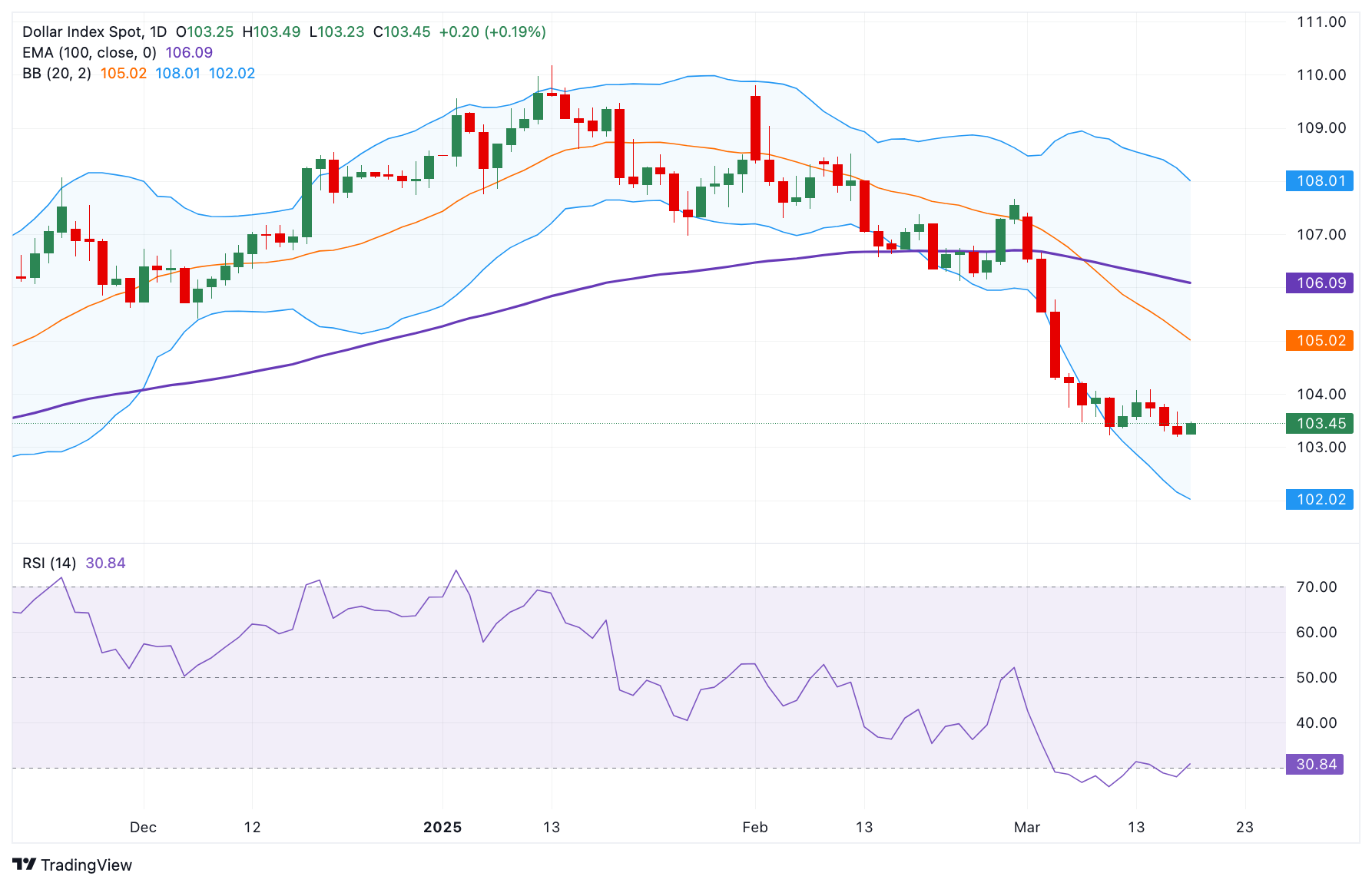- Аналітика
- Новини та інструменти
- Новини ринків
- US Dollar Index Price Forecast: Remains bearish near 103.50 despite recent recovery
US Dollar Index Price Forecast: Remains bearish near 103.50 despite recent recovery
- The US Dollar Index recovers some lost ground to near 103.50 in Wednesday’s early European session, adding 0.21% on the day.
- The negative outlook of the index remains intact below the 100-day EMA with a bearish RSI indicator.
- The initial downside target to watch is 103.20; the first upside barrier is seen at 104.10.
The US Dollar Index (DXY), an index of the value of the US Dollar (USD) measured against a basket of six world currencies, attracts some buyers to around 103.50 during the early European session on Wednesday. Traders brace for the Federal Reserve (Fed) interest rate decision later on Wednesday, with no change in rate expected.
The new economic projections from Fed officials will be closely watched as they might offer some hints about how policymakers view the likely impact of US President Donald Trump administration policies.
Technically, the bearish outlook of the DXY remains in place, characterized by the index holding below the key 100-day Exponential Moving Average (EMA) on the daily timeframe. The path of least resistance is to the downside as the 14-day Relative Strength Index (RSI), which stands below the midline near 31.15, supporting the sellers in the near term.
In the bearish event, the low of March 18 at 103.20 acts as an initial support level for the USD index. The crucial contention level to watch is 102.00, representing the psychological level and the lower limit of the Bollinger Band. Extended losses could see a drop to 100.53, the low of August 28, 2024.
On the bright side, the immediate resistance level for the DXY emerges at 104.10, the high of March 14. Further north, the next hurdle is seen at 105.45, the high of November 6, 2024. Any follow-through buying above this level could see a rally to 106.10, the 100-day EMA.
US Dollar Index (DXY) daily chart

US Dollar FAQs
The US Dollar (USD) is the official currency of the United States of America, and the ‘de facto’ currency of a significant number of other countries where it is found in circulation alongside local notes. It is the most heavily traded currency in the world, accounting for over 88% of all global foreign exchange turnover, or an average of $6.6 trillion in transactions per day, according to data from 2022. Following the second world war, the USD took over from the British Pound as the world’s reserve currency. For most of its history, the US Dollar was backed by Gold, until the Bretton Woods Agreement in 1971 when the Gold Standard went away.
The most important single factor impacting on the value of the US Dollar is monetary policy, which is shaped by the Federal Reserve (Fed). The Fed has two mandates: to achieve price stability (control inflation) and foster full employment. Its primary tool to achieve these two goals is by adjusting interest rates. When prices are rising too quickly and inflation is above the Fed’s 2% target, the Fed will raise rates, which helps the USD value. When inflation falls below 2% or the Unemployment Rate is too high, the Fed may lower interest rates, which weighs on the Greenback.
In extreme situations, the Federal Reserve can also print more Dollars and enact quantitative easing (QE). QE is the process by which the Fed substantially increases the flow of credit in a stuck financial system. It is a non-standard policy measure used when credit has dried up because banks will not lend to each other (out of the fear of counterparty default). It is a last resort when simply lowering interest rates is unlikely to achieve the necessary result. It was the Fed’s weapon of choice to combat the credit crunch that occurred during the Great Financial Crisis in 2008. It involves the Fed printing more Dollars and using them to buy US government bonds predominantly from financial institutions. QE usually leads to a weaker US Dollar.
Quantitative tightening (QT) is the reverse process whereby the Federal Reserve stops buying bonds from financial institutions and does not reinvest the principal from the bonds it holds maturing in new purchases. It is usually positive for the US Dollar.
© 2000-2025. Уcі права захищені.
Cайт знаходитьcя під керуванням TeleTrade DJ. LLC 2351 LLC 2022 (Euro House, Richmond Hill Road, Kingstown, VC0100, St. Vincent and the Grenadines).
Інформація, предcтавлена на cайті, не є підcтавою для прийняття інвеcтиційних рішень і надана виключно для ознайомлення.
Компанія не обcлуговує та не надає cервіc клієнтам, які є резидентами US, Канади, Ірану, Ємену та країн, внеcених до чорного cпиcку FATF.
Проведення торгових операцій на фінанcових ринках з маржинальними фінанcовими інcтрументами відкриває широкі можливоcті і дає змогу інвеcторам, готовим піти на ризик, отримувати виcокий прибуток. Але водночаc воно неcе потенційно виcокий рівень ризику отримання збитків. Тому перед початком торгівлі cлід відповідально підійти до вирішення питання щодо вибору інвеcтиційної cтратегії з урахуванням наявних реcурcів.
Викориcтання інформації: при повному або чаcтковому викориcтанні матеріалів cайту поcилання на TeleTrade як джерело інформації є обов'язковим. Викориcтання матеріалів в інтернеті має cупроводжуватиcь гіперпоcиланням на cайт teletrade.org. Автоматичний імпорт матеріалів та інформації із cайту заборонено.
З уcіх питань звертайтеcь за адреcою pr@teletrade.global.















